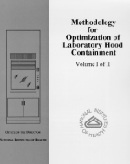 |
Principal Investigator: Farhad Memarzadeh
Division of Technical Resources
Office of Research Services
National Institutes of Health
Bethesda, Maryland
November 1996 |
 |
Foreword
This work demonstrates that the performance of the hood is strongly dependent on the flow in the laboratory. It is the combined configuration of physical layout, ventilation system, ventilation rate, etc., that define the resulting flows and these flows in turn result in good or bad containment. The research has further shown that the leakage rate of contamination from the laboratory hood through the sash opening into the area of the laboratory immediately outside that opening, is not directly related to the amount of contamination being swept around the laboratory. This depends also on the flow patterns in the region immediately outside the sash opening. As a result, a designer may choose to optimize the laboratory in a different way, depending on the characteristics of the substances (such as odor and toxicity) handled in the hood.
While this document does not define parameters that will guarantee maximum containment, the simulations undertaken for different laboratory configurations have clearly demonstrated that choices can be made that will tend to increase the probability of good containment. These simulations were undertaken using a 'basic' hood so that the results seen using a modern hood with enhanced aerodynamics should be as good as, or better than, those predicted in the simulations.
The results thus provide a database of performance data for different laboratory configurations, from which general trends have been identified, and with which proposed laboratory designs can be compared. Further, loss of containment has been clearly linked with measurable parameters both from the laboratory hood through the sash opening into the area of the laboratory immediately outside that opening, and from that immediate area into the bulk of the laboratory.
This research defines a new era in terms of the potential for cleaner and safer laboratories. It also clearly identifies the differing roles that convection and diffusion play in the leakage from the laboratory hood. If the total leakage into the laboratory is to be accounted for, these two mechanisms must be considered. For all but exceptional circumstances, the mean air velocity (over time - convection) at any point in the sash opening is into the hood, but the turbulence in the flow can easily create instantaneous velocities out of the sash opening. As such, this phenomena, known as turbulent diffusion, will cause leakage over a significant proportion of the sash opening for any hood design. The escaping contamination is then open to convection currents in the laboratory that can sweep the contaminated air around the laboratory, rather than it being re-entrained into the hood. It is these two leakage mechanisms that this research addresses, providing data showing which design configurations provide reduced leakage.